With so many “action cameras” around, it’s hard to choose which one is best for you. There are various types of action cameras that are used from car racing to sky-diving to mountain biking to skateboarding or any other activity you can think of. You name it and it probably had an action camera involved in it somewhere. To ask which camera or camera maker is the best may come down to the features and accessories the camera has and how it benefits the user. And with the BlackVue Sport from Pittasoft, this may be the action camera you are looking for.  If you enjoy being in the front seat of any action sequence, such as front of a race car screaming around a corner track, or being on the handlebar of a mountain bike as it rattles down a steep hill, or even watching the transition of day turning into night through a series of time-lapse images, then you obviously like the intimate first person point of view captured on today’s action POV camera.
If you enjoy being in the front seat of any action sequence, such as front of a race car screaming around a corner track, or being on the handlebar of a mountain bike as it rattles down a steep hill, or even watching the transition of day turning into night through a series of time-lapse images, then you obviously like the intimate first person point of view captured on today’s action POV camera.
Introducing the BlackVue Sport SC500 action camera. It’s a mountable, wearable, and portable video 12MP camera that takes still pictures as well as time-lapse images. At first glance, it has the same cubist body type as a GoPro cameras that you may have seen or seen reviewed here at The Gadgeteer. However, I like the more organic, softer edges of the BlackVue than the plainer style of the GoPro cameras. The BlackVue is roughly 2″x 1.5″x 1.75″ in dimension and about 2.5 ounces in weight. 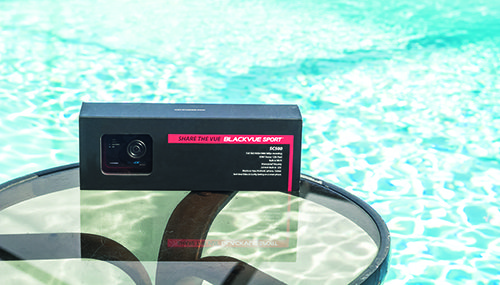 Upon receiving the BlackVue Sport camera, I was pleased to see that it came in a nice sturdy box. I like it when a product has as much thought put into the packaging and presentation as went into the product itself, especially high-end electronics. I tend to keep some of the better packaged boxes handy in case I need to store my devices, and it’s nice when the box is sturdy and presentable. However, I am not obsessed over packaging; it’s just I can’t stand those clear plastic blister packages that are so difficult to open. Anyway, the BlackVue Sport was nicely boxed and had all its accessories neatly tucked away inside.
Upon receiving the BlackVue Sport camera, I was pleased to see that it came in a nice sturdy box. I like it when a product has as much thought put into the packaging and presentation as went into the product itself, especially high-end electronics. I tend to keep some of the better packaged boxes handy in case I need to store my devices, and it’s nice when the box is sturdy and presentable. However, I am not obsessed over packaging; it’s just I can’t stand those clear plastic blister packages that are so difficult to open. Anyway, the BlackVue Sport was nicely boxed and had all its accessories neatly tucked away inside. 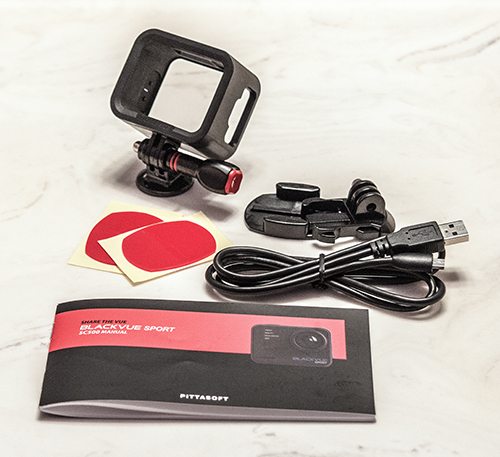 The BlackVue Sport comes with a microUSB charging cable, a couple of mounts and a mount screw, 2 adhesive tapes, a rubber frame mount, and a users manual. I really like the fact that one of the mounts has a metal tripod screw hole on the bottom. That comes in really handy for using either small, portable pocket tripods or regular sized tripods.
The BlackVue Sport comes with a microUSB charging cable, a couple of mounts and a mount screw, 2 adhesive tapes, a rubber frame mount, and a users manual. I really like the fact that one of the mounts has a metal tripod screw hole on the bottom. That comes in really handy for using either small, portable pocket tripods or regular sized tripods. 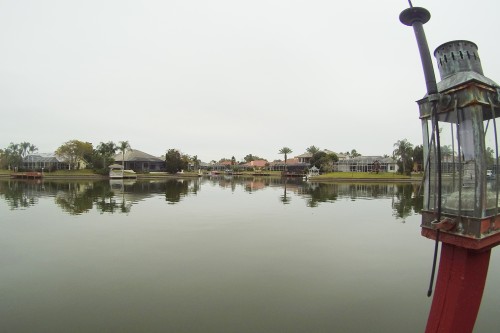 As you can see from the picture of the bay above, for a super wide-angle camera, the center weight of the image has a decently straight horizontal, unlike some wide-angle cameras that have a fish-eye effect that barrels, or has a rounding distortion to the entire image. There is more distortion towards the edge of the image and not the center. This is good, considering I could always crop out the distortion if I wanted to. Keep in mind though that the houses are further away, so distortion won’t be so obvious. With objects that are closer, it may be more noticeable.
As you can see from the picture of the bay above, for a super wide-angle camera, the center weight of the image has a decently straight horizontal, unlike some wide-angle cameras that have a fish-eye effect that barrels, or has a rounding distortion to the entire image. There is more distortion towards the edge of the image and not the center. This is good, considering I could always crop out the distortion if I wanted to. Keep in mind though that the houses are further away, so distortion won’t be so obvious. With objects that are closer, it may be more noticeable.
The BlackVue uses a Sony EXMOR 12MP CMOS sensor with a 157º lens for bright and sharp images. I reviewed a Lorex Active HD camera which had manual exposure settings allowing you to control brightness and exposure; however, I found the BlackVue camera had decent low-light exposure on its own. I actually held the BlackVue camera under my editing desk just around dusk when the sun was just out of the sky but still daylight, and I could make out the plugs and power strips on the back of the LCD screen without any problems. The screen didn’t look washed out or have a low contrasty grainy image. It actually looked pretty decent. Now this is no proven way to accurately test the low light effectiveness of a camera, but considering that I could still have a decent image under a desk at dusk was pretty impressive.
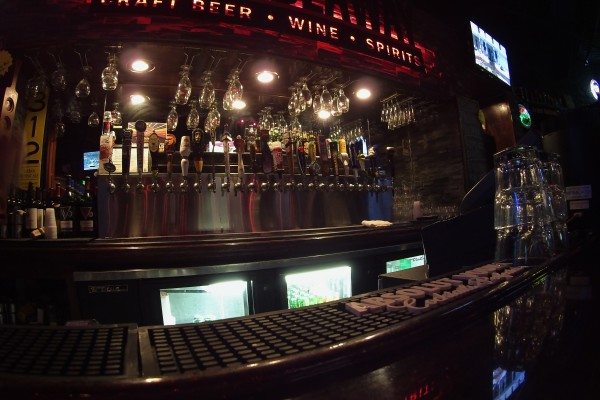
 Here are a couple of pictures I took at one of our neighborhood bars. The was very little lighting inside. The lights were mainly coming off of the TVs and the accent lights around the bar. The only overhead lights were low lit incandescent lights above. The pictures are untouched, and they seem to have decent exposure without obvious grain. The BlackVue Sport can capture JPEG images sizes at 0.3M, 7.2M, 8.5M, and 12M resolution.
Here are a couple of pictures I took at one of our neighborhood bars. The was very little lighting inside. The lights were mainly coming off of the TVs and the accent lights around the bar. The only overhead lights were low lit incandescent lights above. The pictures are untouched, and they seem to have decent exposure without obvious grain. The BlackVue Sport can capture JPEG images sizes at 0.3M, 7.2M, 8.5M, and 12M resolution.
One thing that I think is absolutely necessary with a POV camera is a viewing screen. Fortunately, the BlackVue comes with a detachable 2″ LCD screen that you pop onto the back of the camera. Having a LCD screen is necessary to frame your shots without second guessing if your subject is in view. Plus you have the opportunity to review any video footage captured or a picture you just took. No waiting until you get home to playback on your computer to see what you captured. And speaking of playback, the BlackVue Sport has a HDMI-out port, so with the necessary cable, you can review and play your footage on your HDTV. Unfortunately, the HDMI cable is not included.
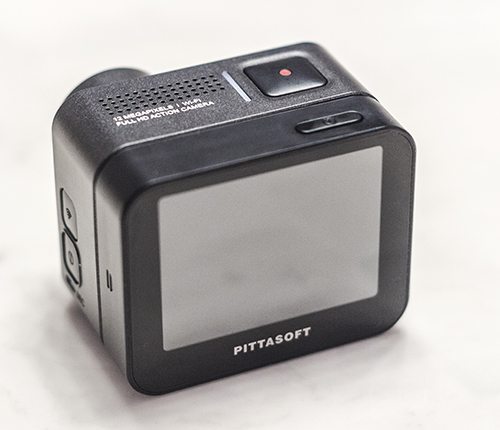
Another feature that I liked about the BlackVue is the built-in WiFi, which allows you to communicate with the camera via the free BlackVue Sport app. With the app, you can take advantage of the Live View function on your Apple or Android phone. You can watch recorded videos or view picture images you took with the camera, and you can also make minor changes to the camera as well with the app. I especially like using my Samsung Note 2 as a wireless viewfinder and monitor. However, there were a few times were I could not get the WiFi to turn on. Normally you would just press the WiFi button on the side of the camera and it pops on. It failed a few times when I tried to turn it on, so I had to power down the camera, pull the battery out, then turn the camera back on to get the WiFi working properly. Inconvenient, yes, but not a deal breaker for me. But in all fairness, I shouldn’t have to restart the camera to get the WiFi to work. Maybe it just needs a firmware update.
Here is a picture taken with the BlackVue camera of my Samsung Note 2 using the BlackVue app with the Live View on.
And speaking of removing the battery, I took the BlackVue camera with me on a weekend trip to Orlando, Florida with my family. Naturally, I used the camera every chance I could get. Unfortunately, a handful of times I had to pull the battery because the camera seemed to be frozen. I pressed the record button to record a few seconds of my family, but when I pressed the record button again to stop recording there was no response. The red dot at the top of the screen that lets you know you are recording would not go away. There was no response from any button I tried pressing, and I had to pull the battery to get the camera working again. This wouldn’t have been a big deal, but since I had the camera in the Frame Mount, it was cumbersome to remove the Frame Mount, then the LCD screen, then open the battery door to finally take out the battery. Maybe it was because I was heavily using the camera, but a handful of times to reset the camera is bothersome.
On a side note, the battery is rated to have a life of about 2 hours, and that seemed accurate from my use of the camera. But I found battery life can vary depending on usage, climate, leaving LCD screen on or off, and whether you conserve battery life by turning the camera off when not in use.
With the BlackVue app you can make changes to your camera’s settings such as the ISO, camera megapixel resolution, high-speed frame rate, self-timer, and a few more. It is probably easier to just make these camera setting changes right from the camera without the need for the app.
The BlackVue Sport has a high-speed recording mode for HD slo-motion videocapture at 120 frames per second. The footage for the slo-motion was decent and looked pretty good on playback. I know I will be using this feature alot. Slow motion footage really gets good emotional value from a scene. The BlackVue records at 720p at 120 frames per second or 480p at 240 frames per second. You’ll have super smoother slo-motion footage, but the trade-off is that the resolution is scaled down to regular SD footage. Unfortunately, you are unable to record 1080p; if you want HD footage, you will have to settle for the 720 HD. Of course, for better HD footage you should be using a Class 10 microSD card for smoother recording and playback. The BlackVue Sport records 1080p at 60 and 30 fps, 720p at 120, 60 and 30fps, and 480p at 240, 60 and 30 frames per second.
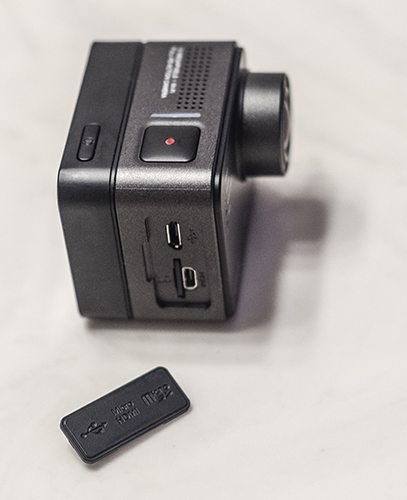 On one side of the camera behind a small cover panel are the ports for the microUSB and HDMI cables. In the same area is the slot for the microSD card. One thing that bothered me is the way BlackVue designed the port door. It pops off effortlessly, but it is not tethered to the camera body in any way. To me, this is an easy way to lose the cover door. I would prefer it to be attached to the body even with some kind of thin plastic strip. I shouldn’t have to worry about misplacing the port cover while charging the battery.
On one side of the camera behind a small cover panel are the ports for the microUSB and HDMI cables. In the same area is the slot for the microSD card. One thing that bothered me is the way BlackVue designed the port door. It pops off effortlessly, but it is not tethered to the camera body in any way. To me, this is an easy way to lose the cover door. I would prefer it to be attached to the body even with some kind of thin plastic strip. I shouldn’t have to worry about misplacing the port cover while charging the battery.
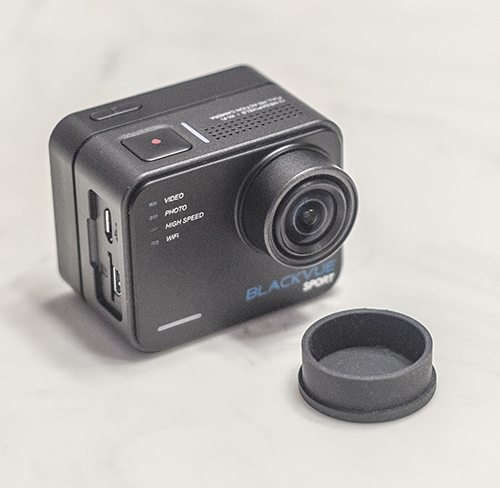 Since we are on the subject of losing things, BlackVue should have really come up with a better cap for the lens. Right now, the lens cap is just a small rubber sleeve. After some use, the little rubber cover did not stay on the lens well. I could literally have the rubber cover on the lens and tilt the camera down and it would slide right off. This is not a good thing in my book, especially if I have the camera in my gear bag and the rubber cover pops off, leaving the lens vulnerable to being scratched or damaged. I had to make do by using a rubber band to keep the cap on the camera.
Since we are on the subject of losing things, BlackVue should have really come up with a better cap for the lens. Right now, the lens cap is just a small rubber sleeve. After some use, the little rubber cover did not stay on the lens well. I could literally have the rubber cover on the lens and tilt the camera down and it would slide right off. This is not a good thing in my book, especially if I have the camera in my gear bag and the rubber cover pops off, leaving the lens vulnerable to being scratched or damaged. I had to make do by using a rubber band to keep the cap on the camera.
All in all, I really liked the BlackVue Sport Action camera. It is so portable and handy to have around. Plus the resolution and picture quality is something to be desired.
There wasn’t a list price on BlackVue’s website but I read somewhere that it may be in the $300 range.
Below is a small video of some clips I shot with the BlackVue SPort SC500.
INIU Mini Portable Charger, Small 45W PD Power Bank, 10000mAh USB C in&Out Fast Charging Pocket Size Battery Pack, Travel Essentials Powerbank for iPhone 17 16 15 14 Pro Air, Xiaomi, Samsung S24 etc
32% OffANDERY Car Phone Holder for Magsafe [78+LBS Strongest Suction & 2400gf Magnetic] 360° Adjustable Car Phone Mount, Phone Holders for Your Car for iPhone 17 Pro Max 16 15 14 13 12 Air Plus, Carbon Fiber
37% OffProduct Information
| Price: | $300 |
| Manufacturer: | Pittasoft BlackVue SPort |
| Pros: |
|
| Cons: |
|

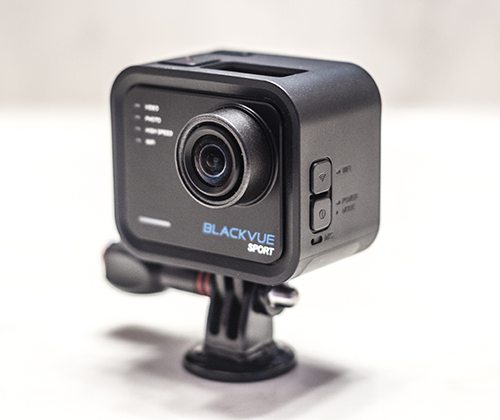
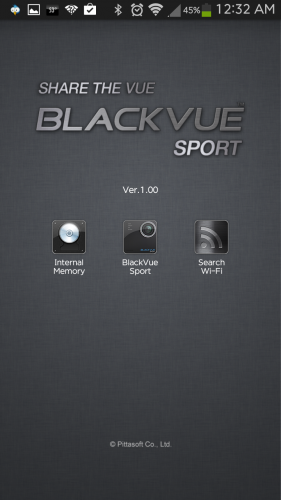
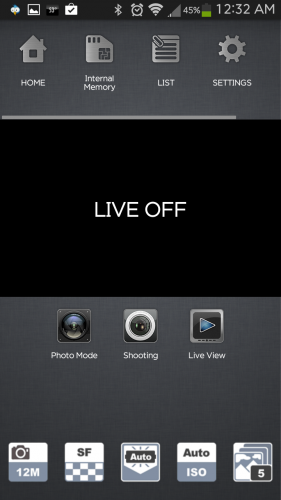
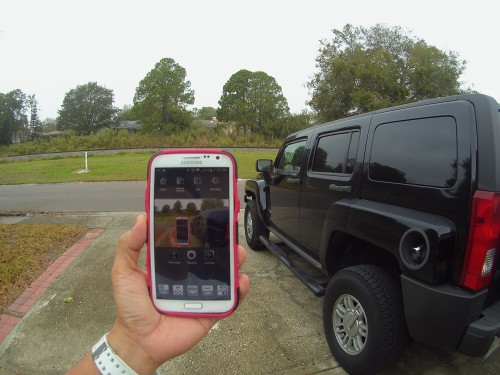
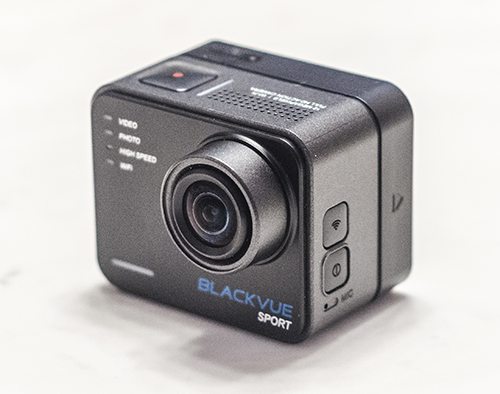



Gadgeteer Comment Policy - Please read before commenting
It’s a felony to trespass on railroad tracks. Plus it makes you look like a moron, asking to be run over.
Wow! Moron?…
And I don’t even know you.
But thanks for the input. I’ll have to tell the numerous neighbors in our neighborhood that walk across the tracks to cut to the City Park. Of course the train tracks are literally 2o yards opposite my driveway on the other side of an empty street and where the tracks and are unobstructed by anything seeing how you can see about half a mile in either direction.
Plus, trains run in our residential area about every few days mainly in the wee hours of the night because we can hear the train go by when we stay up super late to watch a movie.
Fortunately, I was on their about 5:30 in the afternoon. And more often than not, the only railway vehicles that creep by are vehicles like hi-rail grapple and ballast regulators. We like to wave to the operators when they go by. They wave back.
Oh, I did see a few engines go by when we are playing out front since I basically live on a dead end street so there is rarely any traffic. It’s kind of boring on our quiet street.
But I think I have seen 4 or 5 engines go by about 8-10 mph in the 3 years I’ve lived here. Don’t get me wrong a handful of trains have come by over the years but I don’t think I was asking to be run over by a plodding locomotive.